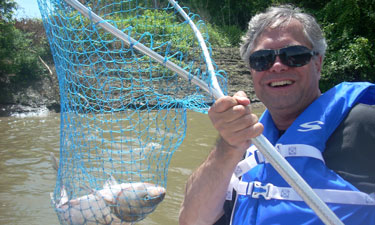 Silver and bighead carp, collectively known as Asian carp, were imported from China in the 1970s as a biological control to remove algae and improve water quality in fish farms in Arkansas. Unfortunately, both species escaped captivity during flooding, and these fast-growing, plankton-eating fish quickly expanded their range throughout the Missouri/Mississippi River Basin. In the ensuing years, they have swiftly spread up the Illinois River in the direction of the Great Lakes and can now be found in 40 states.
Silver and bighead carp, collectively known as Asian carp, were imported from China in the 1970s as a biological control to remove algae and improve water quality in fish farms in Arkansas. Unfortunately, both species escaped captivity during flooding, and these fast-growing, plankton-eating fish quickly expanded their range throughout the Missouri/Mississippi River Basin. In the ensuing years, they have swiftly spread up the Illinois River in the direction of the Great Lakes and can now be found in 40 states.
Because they reduce primary food sources for native species, in this case catfish, paddlefish, buffalo and gizzard shad, Asian carp pose serious problems for aquatic ecosystems. Massive die-offs of carp affect our nation’s waterways because of bacterial contamination and the odor from dead fish, thus hindering tourism. Moreover, silver carp, which can grow to more than 100 pounds, tend to leap from the water when disturbed, causing property damage and personal injury to recreational boaters. Efforts are underway by the U.S. Army Corps of Engineers to prevent Asian carp from entering the Great Lakes, threatening a multibillion dollar commercial and recreational fishing industry.
Invasive species, such as Asian carp, are difficult to eradicate once they occupy an ecological niche. Since carp cannot be caught by rod and reel, angling is not a solution, and carp tournaments only provide temporary relief. Commercial harvest is a viable option, but the supply of fish is much larger than current demand. Some uses include as fertilizer, bait, fish oil and pet food. Human consumption is a solution if the image problem can be overcome.
Merging Social Science with Natural Resources
In the United States, silver and bighead carp are regarded as “trash” fish mainly due to their appearance and boniness which makes them difficult to fillet. In contrast, I learned from my visits to China, Vietnam and Thailand, that carp are highly revered in Asian culture, often featured in artwork and literature. Eaten regularly in Asian countries, carp are one of the least-consumed fish in the United States. With this cultural insight, I developed “Eat Mo Carp,” a marketing-based strategy designed to promote awareness and consumption of Asian carp in grocery stores and restaurants in Columbia, Missouri.
Asian carp are a plentiful, healthy, and cheap source of protein. The white meat has a mild flavor which contains omega-3 fatty acids and accepts spices and seasonings quite well. Silver and bighead carp have low levels of toxins, such as mercury because of their midstream feeding behavior (people often confuse them with grass and common carp, both of which are bottom-feeders). Use of locally grown, harvested and processed food is a good way to create consumer demand and address an important environmental issue in our nation’s waterways. This was a unique opportunity for me to merge social science with natural resources. All too often we hear of stories that pit jobs against the environment. Carp, in this context, represents a win-win situation.
Addressing the Problem: One Forkful at a Time
Although education is important, it’s not sufficient to change attitudes and behavior. Taste wins. My research team, consisting of two graduate students and a food scientist, conducted a blind taste test on the University of Missouri’s campus using two-ounce portions of oven-baked fish. We found that silver carp beat catfish by a significant margin. Catfish are the most eaten fish in Missouri, at home or in restaurants. Armed with this new information, we gave some minced product to the University of Missouri Fisheries Club for its fundraising efforts. Asian carp proved to be very popular among college students. I talked to the university’s head chef, and he prepared some carp dishes for others to try. As a result, Mizzou became first in the nation to serve Asian carp on campus. We also offered free samples of carp chili at Moser’s Supermarket in Columbia and received positive feedback from shoppers. Moser’s started carrying the frozen ground product in October 2014 and sales have been steady since that time. Bass Pro in Springfield, Missouri, asked our team to be a carp food vendor at several outdoor events. Carp fear us.
Broadway Brewery in downtown Columbia has adopted and fully endorsed our project. After agreeing to serve Asian carp, we convinced them to kick off their new menu with a benefit concert in June 2015. It was a smashing success — 75 people attended the event, ate some delicious carp cuisine and listened to several local musicians. We provided T-shirts and Bass Pro gave us some silent auction items. Since introduction, the carp spring rolls have outsold every other appetizer on the menu.
The carp craze is catching on in Missouri. I order from Schafer Fisheries in Thomson, Illinois, which makes a 100 percent boneless product, similar to ground turkey. It can serve as an environmentally friendly source of protein for a variety of food products that many Americans love to eat, such as chili, tacos, burritos and omelets. Smoked sausage is my personal favorite. Eating carp is a healthy and delicious way to address the invasive species problem, one forkful at a time. Carpe Diem!
Mark Morgan, Ph.D., is Project Director of Eat Mo Carp and an Associate Professor of Parks, Recreation and Tourism at the University of Missouri.

